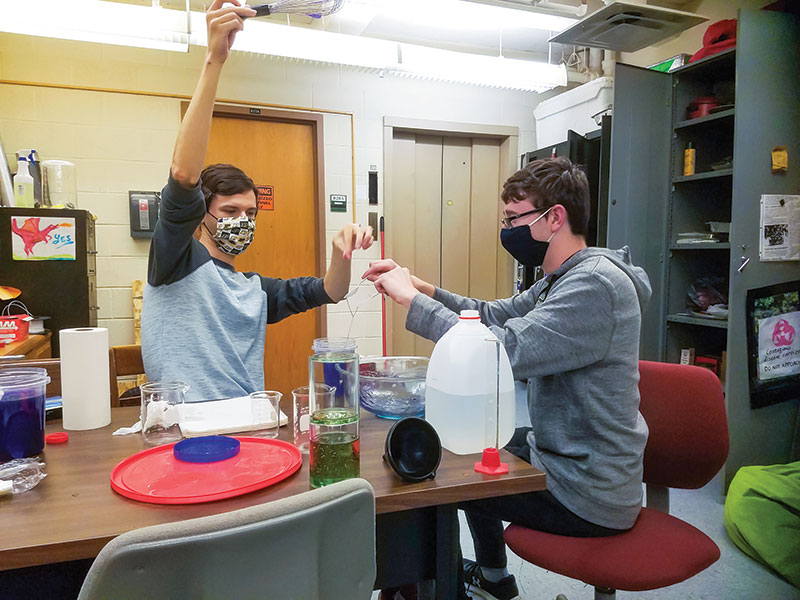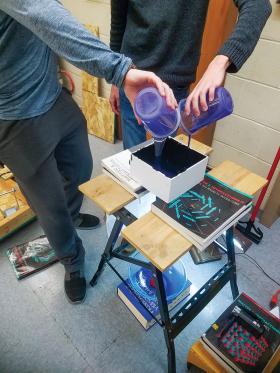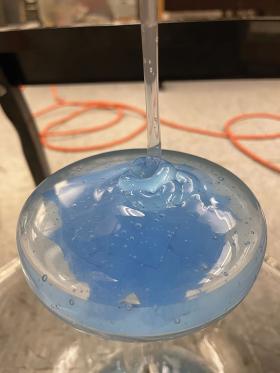The Goop Project
Fall
2022
Building Blocks - Undergraduate Research and Outreach Projects
The Goop Project
Bianca Caminada, SPS Member, Purdue University, with the rest of the Goop Project Team: Matt Schulz, Albert Xu, Ben Hayward, Alan Wright, Andrew Gustafson, David Lamey, Ethan Pinarski, and Will Messman
 If you had walked into Purdue University’s SPS lounge around March 2020, you would have seen a group of students enthusiastically passing around and turning over a cylindrical hourglasslike container partially filled with green goop.
If you had walked into Purdue University’s SPS lounge around March 2020, you would have seen a group of students enthusiastically passing around and turning over a cylindrical hourglasslike container partially filled with green goop.
We were fascinated by how the goop fell from one end of the container to the other when it was flipped upside down. A thin strand of goop pulled away from the whole and, like one end of a rope, fell to the bottom of the cylinder and began forming circular patterns. This coiling behavior continued until the last of the green goop fell to the bottom.
“What if we studied it?” asked our then SPS chapter secretary Matt Schulz, who had watched a YouTube video on the phenomenon, known as the liquid rope coiling effect. This behavior occurs with many viscous liquids, including honey and maple syrup.
And that’s how it would have begun—if not for the onset of the COVID-19 pandemic the following week. School shut down and most of us went home, not knowing when we would all be back together. However, the Purdue SPS leadership was determined to maintain our community, even if we had to switch to online methods of interaction.
In the fall of 2020, Schulz, now chapter vice president, suggested we study the effect even though we couldn’t all be in the lab together. Over a Discord call, he and other chapter members introduced eager first-year students to the liquid rope coiling effect, and our SPS chapter research project finally began. What better way to bond future scientists than with physics, experimental data, and discussions of the best ratio of syrup-to-pancake?
 What started as entertainment quickly evolved into a proper scientific investigation. In late 2020 our chapter received a Chapter Project Award from SPS National, and we started designing the experiment. We had moved on from the early days of studying a fluid trapped in a jar to building a chamber for studying liquids of different viscosities. With this, we would analyze how the polymerization and viscosity of fluids affect their liquid rope coiling behavior.
What started as entertainment quickly evolved into a proper scientific investigation. In late 2020 our chapter received a Chapter Project Award from SPS National, and we started designing the experiment. We had moved on from the early days of studying a fluid trapped in a jar to building a chamber for studying liquids of different viscosities. With this, we would analyze how the polymerization and viscosity of fluids affect their liquid rope coiling behavior.
After multiple designs, we settled on using a long PVC tube with a cube reservoir at the top. One to two liters of polymer solution (our homemade “goop”) poured in the top would slowly fall through the tube while the pressure at the bottom of the apparatus stayed roughly constant.
Underneath the tube sat a watch glass–covered graduated cylinder. When the goop fell onto this surface, we captured the coiling effects on camera. We placed the whole apparatus on an adjustable-height workbench so that we could change the height from which the goop fell.
After a multitude of (failed) attempts to design our desired fluids, we settled for comparing two polymer fluids with different concentrations of polymer lengths. We were trying to create two fluids with very different viscosities, like those of thick maple syrup and ketchup. As it turned out, we ended up with two solutions that physically resembled each other but demonstrated different coiling behaviors.
We collected footage of the coiling behavior of both fluids as they fell from various heights. From the video, we extracted data on where the liquid rope touched the surface (its position) as a function of time. Then we used a fast Fourier transform to extract the frequency of the coiling for that specific run—that is, how many times per second the goop coiled. You can think of this as the number of oscillations per second of the falling fluid or its frequency.
 When we increased the fall height past a certain threshold we saw more frequency peaks, which is consistent with the literature. Before this threshold, the coil was in what’s known as the gravitational regime. Beyond the threshold it was in the inertio-gravitational regime. We saw this behavior in both fluids, but we would need further investigation to find and compare the bifurcation height that separates the two regimes in each fluid. We did observe an inverse dependency between frequency and viscosity in the gravitational regime for both fluids, which is consistent with a 2006 paper by N. M. Ribe, M. Habibi, and D. Bonn on the stability of liquid rope coiling.1
When we increased the fall height past a certain threshold we saw more frequency peaks, which is consistent with the literature. Before this threshold, the coil was in what’s known as the gravitational regime. Beyond the threshold it was in the inertio-gravitational regime. We saw this behavior in both fluids, but we would need further investigation to find and compare the bifurcation height that separates the two regimes in each fluid. We did observe an inverse dependency between frequency and viscosity in the gravitational regime for both fluids, which is consistent with a 2006 paper by N. M. Ribe, M. Habibi, and D. Bonn on the stability of liquid rope coiling.1
Like most investigations, the scope of our project evolved as we found out what worked and what didn’t. We spent a lot of time constructing and optimizing the setup, which included making and finding the right parts. And as we did, we plowed through the difficulties presented by COVID-19 limitations.
To our chapter the goop project became more than just a fulfillment of curiosity; it kept us connected. We worked together, even though we had to be physically separated much of the time. The following year, when we were trying to settle back into campus life in its new format, the project served as a way to rope in new members and give them something tangible to work on. The goop was a silent friend that tied our chapter together during these challenging times.
References
1. N. M. Ribe, M. Habibi, and D. Bonn, “Stability of Liquid Rope Coiling,” Phys. Fluids 18, 084102 (2006), doi.org/10.1063/1.2336803.
Get Money for Chapter Research
SPS Chapter Research Awards provide up to $2,000 for physics research projects that are deemed imaginative and likely to contribute to the strengthening of the SPS program. For details, visit spsnational.org/awards/chapter-research.
More from this department
Building Blocks - Undergraduate Research and Outreach Projects
